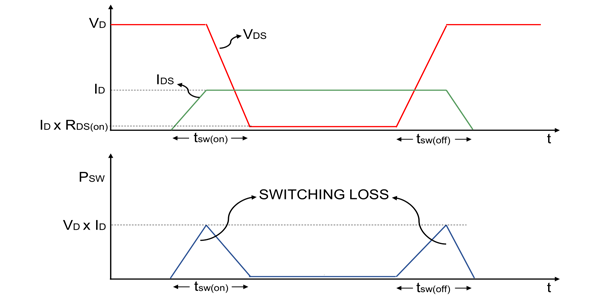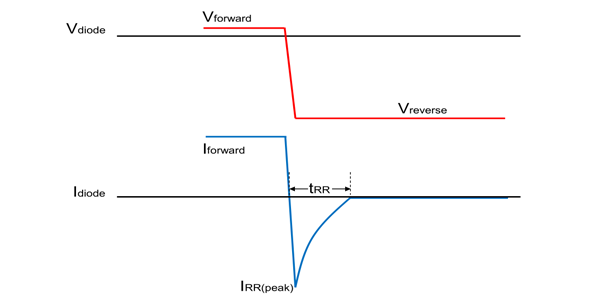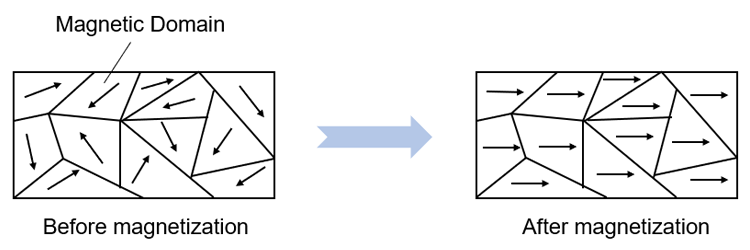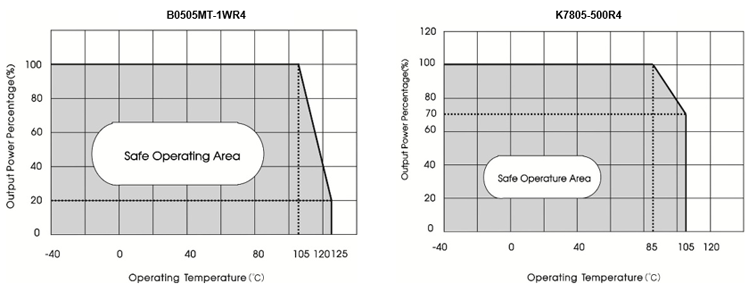A Brief Introduction to Thermal Performance of Modular Switching Power Supply
With the fast development of technology, various industries request modular power supply to be miniaturization. Under this trend, the thermal performance of modular power supply becomes the key factor which affects the reliability and life cycle of electronic devices.
There are two methods to improve thermal performance of modular power supply, one is to reduce the heat from the source, and the other is to focus on heat dissipation and accelerate the heat export.
I. Major loss of switching power supply
To reduce the heat of modular power supply means to reduce the loss of switched-mode power supply. Nowadays mainstream modular power supplies are switching power supplies, and its loss includes switching loss, on-state loss, and core loss etc.
A. Switching loss
Switching loss means the loss generated by power switch, such as MOS and Diode, which are switching on and off according to duty ratio. As shown in Figure 1 which is MOS switch status diagram, it can be seen that switch change is not completed in an instant, and switching loss is the overlapping part between the current and voltage.

Fig. 1 MOS Switch Status Diagram
The switching loss of the diode is mainly the reverse recovery loss, that is the loss caused by the diode from the forward conduction to the reverse blocking. As shown in Figure 2, when the diode reversely recovers, the charge accumulated during forward conduction needs to be released, then a reverse current IRR is generated. The area where this current overlaps with the reverse voltage is the reverse recovery loss.

Fig. 2 Diode Reverse Recovery Diagram
B. On-state loss
On-state loss refers to the loss of the circuit loop in the conduction state, including the resistance loss (the loss generated by MOS RDS-on is included) in the loop and the conduction loss of the diode etc.
Resistance loss is the power loss generated by the loop current Iloop flowing through all the resistance Rloop in the loop, and its value is Iloop2Rloop. The conduction loss of the diode is the product of the current ID which flows through the diode and the forward conduction voltage Vf.
C. Core loss
The loss of transformer or inductor mainly includes coil loss and magnetic core loss. The coil loss is caused by the coil resistance (DCR) of the transformer or inductor, and this loss belongs to the resistance loss; the core loss mainly includes hysteresis loss and eddy current loss.
Hysteresis loss can be understood as the loss generated by the rotating "friction" of the magnetic domain of the magnetic core during repeated magnetization. As shown in Figure 3, when the magnetic core is in an electric field, its magnetic domain will be deflected by magnetization. Magnetic domain deflection is a movement process that generates heat.

Fig. 3 Magnetic Domain Diagram
The alternating magnetic flux generated by the transformer or inductor during operation will generate an induced voltage. When this voltage is applied to the core body, a corresponding induced current IL is generated. The loss caused by the induced current flowing through the core body resistance RL is eddy current loss, and its value is IL2RL.
There are surely other losses in the circuit, which will not be described here one by one. At present, the circuit technology of various mainstream manufacturers in the industry are not much different, so for modular power supply those with same power and same size or dimension, the efficiency of the power supply is almost similar. Therefore, how to improve the thermal performance of the power supply based on the existing circuit technology mainly depends on heat dissipation.
II. Thermal resistance of modular power supply
By accelerating heat dissipation that is, by reducing the thermal resistance of the modular power supply, heat generation can be reduced. Thermal resistance is the temperature rise caused by unit heat and it reflects the heat transfer capacity of the medium. The basic unit is ℃/W.
There are usually two methods to reduce the thermal resistance, one is to reduce the thermal resistance between the outer surface of the product and the air, and the other is to reduce the thermal resistance inside the product.
The first method is common, which is using external measurements to accelerate heat dissipation, such as air cooling or adding heat sink. This method can accelerate heat dissipation on the modular power supply surface, but this will result in the increase of cost and dimension for customers.
By adopting second method, product's heat dissipation capacity can be improved effectively by reducing thermal resistance inside the product. As shown in Figure 4, it is a diagram of the structure of the modular power supply. When heat is transferred from the heat-generating components to the outside of the product, it first passes through the case of the component, followed by the packaging material, and finally the product case.

Fig. 4 Diagram of the structure of modular power supply
The greater the thermal conductivity of the packaging material and the product case, the better the thermal performance. Therefore, we can use the packaging material and case which are with higher thermal conductivity to reduce the thermal resistance and accelerate heat dissipation.
But in fact, there are some factors that have a great influence on the thermal resistance, and some of them are easy to be ignored, mainly including the air holes inside the packaging material, and the gap between the various joint surfaces.
The products produced by adopting the conventional techniques will have many air holes and gaps inside, which will increase the thermal resistance of the product, so that makes it difficult for the product to achieve a higher operating temperature.
For the modular power supply, current advanced process is SiP (System in Package) packaging technology. Compared with the conventional process, this process can minimize the product dimension and increase the power density, and there will be less and smaller air holes and gaps inside the product. Therefore, the products produced by the SiP packaging technology have lower thermal resistance and excellent heat dissipation performance, which can significantly improve the thermal performance of the product and improve the reliability of the product.
III. Summary
In summary, a modular power supply with excellent thermal performance must be of high efficiency and good heat dissipation.
The Fixed input R4 and non-isolated R4 series launched by MORNSUN are the products that have excellent thermal performance.

Fig. 5 R4 Product and Product Temperature Curve
Thanks to the SiP packaging technology, MORNSUN R4 products achieve the highest operating temperature in the industry, while maintaining a high efficiency. The maximum operating temperature of non-isolated R4 is up to 105℃, and the maximum operating temperature of fixed input R4 is up to 125°C, both of which can meet most of the customer’s application environment demands. Besides, the fixed input and non-isolated R4 products are both ultra-small with size of 9*7*3.1 mm, which is comparable to chips, and with the small size it is of great benefit for customers to miniaturize their own products.






